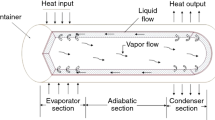Abstract
Heat pipes are widely used for the thermal control of electronic devices due to their capability of heat transport at high rate over considerable distance with small temperature drop. This study investigates the experimental performance of the heat pipe using the combination of copper nanofluids and the different types of aqueous solution of long chain alcohols. An experimental system is set up to measure the temperature distribution of heat pipes along the surface to determine the thermal efficiency and the thermal resistance of different working fluids computed. The working fluids used in this analysis illustrate certain improvement in the metrics over the conventional working fluids, pertaining to the heat transport limitations. The experimental results display higher efficiency and lower thermal resistance of the heat pipe when compared with the conventional working fluids like water.



















Similar content being viewed by others
References
Chi SW (1976) Heat pipe theory and practice: a sourcebook. McGraw-Hill, New York
Cao Y, Faghri A (1991) Transient multidimensional analysis of nonconventional heat pipes with uniform and nonuniform heat distributions. J Heat Transf 113:995–1002
Mughal MP, Plumb OA (1996) An experimental study of boiling on a wicked surface. Int J Heat Mass Transf 39:771–777
Brautsch A, Kew PA (2002) Examination and visualization of heat transfer processes during evaporation in capillary porous structures. Appl Therm Eng 22:815–824
Vochten R, Petre G (1973) Study of the heat of reversible adsorption at the air–solution interface II. Experimental determination of the heat of reversible adsorption of some alcohols. J Coll Interface Sci 42:320–327
Villers D, Platten JK (1998) Temperature dependence of the interfacial tension between water and long-chain alcohols. J Phys Chem 92:4023–4024
Oron A, Rosenau P (1994) On a nonlinear thermo capillary effect in thin liquid layers. J Fluid Mech 273:361–374
Senthilkumar R, Vaidyanathan S, Sivaraman B (2012) Comparative study on heat pipe performance using aqueous solutions of alcohols. Heat Mass Transf 48:2033–2040
Loh CK, Harris E, Chou DJ (2005) Comparative study of heat pipes performances in different orientations. In: Semiconductor thermal measurement and management symposium, pp 191–195
Choi SUS (1994) Enhancing thermal conductivity of fluids with nano-particles. ASME-FED 231:99–105
Tsai CY, Chien HT, Ding PP, Chan B, Luh TY, Chen PH (2004) Effect of structural character of gold nanoparticles in nanofluid on heat pipe thermal performance. Mater Lett 58:1461–1465
Naphon P, Thongkum D, Assadamongkol P (2009) Heat pipe efficiency enhancement with refrigerant–nanoparticles mixtures. Energy Convers Manag 50:772–776
Kang S, Wei W, Tsai S, Huang C (2009) Experimental investigation of nanofluids on sintered heat pipe thermal performance. Appl Therm Eng 29:973–979
Wang G-S, Song B, Liu Z-H (2010) Operation characteristics of cylindrical miniature grooved heat pipe using aqueous CuO nanofluids. Exp Therm Fluid Sci 34:1415–1421
Moraveji MK, Razvarz S (2012) Experimental investigation of aluminium oxide nanofluid on heat pipe thermal performance. Int Commun Heat Mass Transf 39:1444–1448
Do KH, Ha HJ, Jang SP (2010) Thermal resistance of screen mesh wick heat pipes using the water-based Al2O3 nanofluids. Int J Heat Mass Transf 53:5888–5894
Liu ZH, Zhu QZ (2011) Application of aqueous nanofluids in a horizontal mesh heat pipe. Energy Convers Manag 52:292–300
Liu Z-H, Li Y-Y (2012) A new frontier of nanofluid research—application of nanofluids in heat pipes. Int J Heat Mass Transf 55:6786–6797
Hung Y-H, Teng T-P, Lin B-G (2013) Evaluation of the thermal performance of a heat pipe using alumina nanofluids. Exp Therm Fluid Sci 44:504–511
Naphon P, Assadamongkol P, Borirak T (2008) Experimental investigation of titanium nanofluids on the heat pipe thermal efficiency. Int Commun Heat Mass Transf 35:1316–1319
Zhang N (2001) Innovative heat pipe systems using a new working fluid. Int Commun Heat Mass Transf 28:1025–1033
Liu ZH, Yang XF, Guo GL (2007) Effect of nanoparticles in nanofluid on thermal performance in a miniature thermosyphon. J Appl Phys 102:013526-1–013526-8
Hopkins R, Faghri A, Khrustalev D (1999) Flat miniature heat pipes with micro capillary grooves. J Heat Transf 121:102–109
Yang XF, Liu Z, Zhao J (2008) Heat transfer performance of a horizontal microgrooved heat pipe using CuO nanofluid. J Micromech Microeng 18:035038-1–035038-8
Kim HD, Kim J, Kim MH (2007) Experimental studies on CHF characteristics of nano-fluids at pool boiling. Int J Multiph Flow 33:691–709
Acknowledgments
The authors thank the authorities of Annamalai University for providing the necessary facilities in order to accomplish this piece of work.
Author information
Authors and Affiliations
Corresponding author
Rights and permissions
About this article
Cite this article
Senthil Kumar, R., Vaidyanathan, S. & Sivaraman, B. Effect of copper nanofluid in aqueous solution of long chain alcohols in the performance of heat pipes. Heat Mass Transfer 51, 181–193 (2015). https://doi.org/10.1007/s00231-014-1411-4
Received:
Accepted:
Published:
Issue Date:
DOI: https://doi.org/10.1007/s00231-014-1411-4




